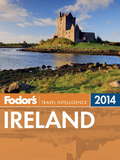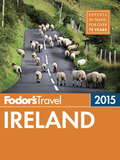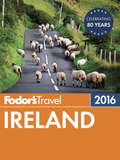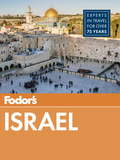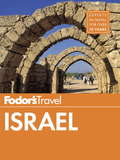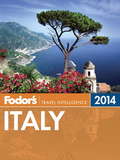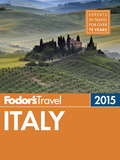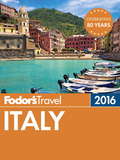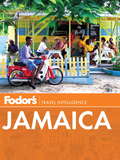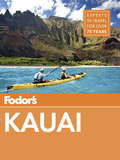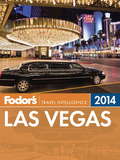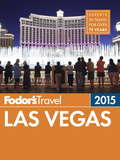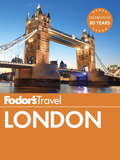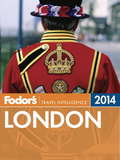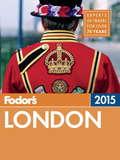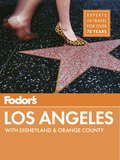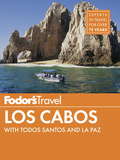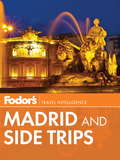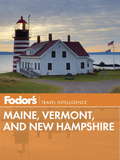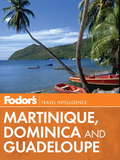- Table View
- List View
Fodor's Ireland 2011
by Fodor'sGet inspired and plan your next trip with Fodor's ebook travel guide to Ireland. Intelligent Planning: Discover all of the essential, up-to-date travel insights you expect in a Fodor's guide, including Fodor's Choice dining and lodging, top experiences and attractions, and detailed planning advice. Easy Navigation for E-Readers: Whether you're reading this ebook from start to finish or jumping from chapter to chapter as you develop your itinerary, Fodor's makes it easy to find the information you need with a single touch. In addition to a traditional main table of contents for the ebook, each chapter opens with its own table of contents, making it easy to browse. Full-Color Photos and Maps: It's hard not to fall in love with Ireland as you flip through a vivid full-color photo album. Explore the layout of city centers and popular neighborhoods with easy-to-read full-color maps. Plus get an overview of Irish geography with the convenient atlas at the end of the ebook. What's Covered? Get to Know Ireland: Kerry and Limerick Counties are nestled in the southwest of Ireland, with sights that top every tourist's must-see list. Make sure you have your camera on hand as you explore the brazen scenic coastal drive of the Ring of Kerry, Ireland's prettiest village, Adare, and walk through Killarney's purple mountains in the Gap of Dunloe. In the southeast, follow in the footsteps of St. Patrick at the Rock of Cashel, dig the ducal lifestyle at Lismore, and romp in the brisk waters of the pristine beaches around the fishing village of Ardmore. After exploring Cork City, be sure to take in the treasures of County Cork---from Blarney Castle to the breathtaking views over Bantry Bay. Set with postcard-perfect villages like Doolin, the lunar landscape of the Burren, and the towering Cliffs of Moher, County Clare are pure tourist gold. Connemara and County Mayo remain the most Irish part of Ireland. Connemara is a misty bogland, studded with deep-blue lakes and distant purple hills while outside the main towns of Castlebar and Westport, the rest of County Mayo has long empty roads leading to isolated shorelines and stunning vistas. The Northwest region of Ireland covers the most northern part of Ireland's Atlantic coastline. From the varied cultural footprints in County Slingo like the Yeats Trail, many travelers head north to Leitrim, a county best know for its lakes flowing in the River Shannon, and then on to County Donegal--isolated, beautiful, and famed for its Celtic inheritance. Northern Ireland has positively bloomed since the peace dividend of recent times. From the beauty of Antrim's coastline to the vibrant cultural renaissance of Derry and Belfast, the region has emerged into a present full of promise and possibility. Cross the Giant's Causeway, slide into a cozy snug in a pub on Belfast's Golden Mile, and trail after Eire's "wee folk" in the shimmery Glens of Antrim. Most travelers to Ireland will not be able to resist a stop over to Dublin, Ireland's capital, and one of Europe's most popular city-break destinations. With magnificent museums including the Hugh Lane and the National Museum, Georgian architecture, and of course, hundreds of pubs, the city's pleasures are uncontainable. Note: This ebook edition is adapted from Fodor's Ireland 2011 but differs in some content. Additionally, the ebook edition includes photographs and maps that will appear on black-and-white devices but are optimized for devices that support full-color images.
Fodor's Ireland 2015
by Fodor'sFodor's correspondents highlight the best of Ireland, including Dublin's elegant architecture, the West's dramatic landscapes, and Northern Ireland's revitalized capital, Belfast. Our local experts vet every recommendation to ensure you make the most of your time, whether it's your first trip or your fifth. MUST-SEE ATTRACTIONS from Temple Bar to the Ring of Kerry PERFECT HOTELS for every budget BEST RESTAURANTS to satisfy a range of tastes GORGEOUS FEATURES on traditional music and literary Dublin VALUABLE TIPS on when to go and ways to save INSIDER PERSPECTIVE from local experts COLOR PHOTOS AND MAPS to inspire and guide your triph a country-wide pull-out map that also covers the city of Dublin. DISCERNING RECOMMENDATIONS: Fodor's Ireland 2015 offers savvy advice and recommendations from local writers to help travelers make the most of their time. Fodor's Choice designates our best picks, from hotels to nightlife. INCLUDES: Dublin, Galway, Cork, Belfast, the Aran Islands, the Ring of Kerry, Connemara, and more. ABOUT FODOR'S AUTHORS: Each Fodor's Travel Guide is researched and written by local experts.
Fodor's Ireland 2016
by Fodor'sWith an array of dazzling photographs, this book deftly guides the traveler through all the sights and experiences--from Connemara to Georgian Dublin to pub culture to Irish dance--that make the Emerald Isle one of Europe's most popular destinations.he Great Itineraries section for suggested routes through different regions of Ireland. The guide comes with a country-wide pull-out map that also covers the city of Dublin. * DISCERNING RECOMMENDATIONS: Fodor's Ireland offers savvy advice and recommendations from local writers to help travelers make the most of their time. Fodor's Choice designates our best picks, from hotels to nightlife. * INCLUDES: Dublin, Galway, Cork, Belfast, the Aran Islands, the Ring of Kerry, Connemara, and more. * ABOUT FODOR'S AUTHORS: Each Fodor's travel guide is researched and written by local experts.
Fodor's Israel 2013
by Fodor'sIsrael packs in riches from cherished religious sites and stunning archaeological remains to spectacular natural wonders. Holy land to Jews, Christians, and Muslims, this is where biblical place names like Jerusalem and the Galilee come alive. Colorful features in Fodor's Israel ebook travel guide help travelers experience all of this and more: awe-inspiring ancient treasures, beautiful landscapes, food and wine, and vibrant contemporary culture. Competitive Advantage: With its focus on modern pleasures as well as historical attractions, Fodor's Israel is the best-selling guide to this exciting, diverse country. It's well positioned to take advantage of growing American travel to Israel: the number of visitors rose more than 50% between 2004 and 2011.Expanded Coverage: This new edition captures the latest developments in this fast-changing country, including the hot restaurant scenes in Tel Aviv and Jerusalem. Tel Aviv's great shopping is covered in more depth, along with its expanding gallery scene. Also getting more attention are the country's spa culture, B&B scene, new resorts, wineries, and transportation improvements. The guide also includes more information on the popular side-trip excursion to Jordan's world wonder of Petra. Illustrated Features: Browsable experiential features highlight quintessential Israel, both ancient and modern. Topics include Masada; the Western Wall and the Dome of the Rock in Jerusalem; the Dead Sea; Jesus in the Galilee; outdoor activities in the Negev desert; nightlife in Tel Aviv; and Israeli wine, giving travelers an unparalleled sense of the country. Short features address Israeli cuisine and Tel Aviv's Bauhaus architecture. Discerning Recommendations: Fodor's Israel ebook edition offers savvy advice and recommendations from local writers to help travelers make the most of their time. Fodor's Choice designates our best picks, from hotels to nightlife. "Word of Mouth" quotes from fellow travelers provide valuable insights.
Fodor's Israel 2015
by Fodor'sFodor's correspondents highlight the best of Israel, including Jerusalem's holy sites, Tel Aviv's cafés and shops, and the Galilee's nature reserves and ancient ruins. Our local experts vet every recommendation to ensure you make the most of your time, whether it's your first trip or your fifth. MUST-SEE ATTRACTIONS from Nazareth to the Negev desert PERFECT HOTELS for every budget BEST RESTAURANTS to satisfy a range of tastes GORGEOUS FEATURES on the Dead Sea, Masada, Israeli wine VALUABLE TIPS on when to go and ways to save INSIDER PERSPECTIVE from local experts COLOR PHOTOS AND MAPS to inspire and guide your triplem. ILLUSTRATED FEATURES: Browsable features highlight quintessential Israel, both ancient and modern. Topics include "The Western Wall and the Dome of the Rock in Jerusalem"; "Bauhaus Style in Tel Aviv", "Masada"; "Jesus in the Galilee"; and the "Wines of Israel", giving travelers an unparalleled sense of the country. INDISPENSABLE TRIP PLANNING TOOLS: The "Experience Israel" chapter provides an overview of the country, with special features on getting around; the best foods and markets; great beaches; and the most interesting activities for kids. Features in each chapter make it easy to prepare for a trip and plan which places to see, and detailed itineraries address specific kinds of visitors, including first-timers. DISCERNING RECOMMENDATIONS: Fodor's Israel offers savvy advice and recommendations from local writers to help travelers make the most of their time. Fodor's Choice designates our best picks, from hotels to nightlife. ABOUT FODOR'S AUTHORS: Each Fodor's travel guide is researched and written by local experts.
Fodor's Italy 2013
by Fodor'sFodor's Italy 2013 Ebook is the essential take-along companion. This updated edition highlights everything that visitors adore--from Italy's art and architecture to glorious Tuscan hill towns to red-hot nightlife, and even more! Expanded Coverage: Fodor's Italy 2013 continues to provide thorough, insightful coverage to this year-after-year top European destination. Dozens of scintillating new reviews are sure to entice first- and even old-timers to hotels and restaurants scattered throughout Rome, Venice, and Florence. Establishments in farther-flung cities and towns are also given their due, and look for deeper coverage of trendy southern Italy destinations, such as Sicily, Puglia, and Basilicata. Indispensable Trip Planning Tools: Convenient overviews show each region and its notable highlights, and chapter planning sections have savvy advice for making the most of travelers' time, with top tips on getting from cities to countryside villages. Discerning Recommendations: Fodor's Italy 2013 offers savvy advice and recommendations from local writers to help travelers make the most of their time. Fodor's Choice designates our best picks, from hotels to nightlife. "Word of Mouth" quotes from fellow travelers provide valuable insights. TripAdvisor Reviews: Our experts' hotel selections are reinforced by the latest customer feedback from TripAdvisor. Travelers can book their Italy stay with confidence, as only the best properties make the cut.
Fodor's Italy 2015
by Fodor'sFodor's correspondents highlight the best of Italy, including Rome's art and architecture, Tuscany's glorious hill towns, and the Amalfi Coast's spectacular views. Our local experts vet every recommendation to ensure you make the most of your time, whether it's your first trip or your fifth. MUST-SEE ATTRACTIONS from Venice to Positano PERFECT HOTELS for every budget BEST RESTAURANTS to satisfy a range of tastes GORGEOUS FEATURES on Italian art, food, and wine VALUABLE TIPS on when to go and ways to save INSIDER PERSPECTIVE from local experts COLOR PHOTOS AND MAPS to inspire and guide your tripbring the many sides of Italy to vibrant life. Included among the photogenic array of riches are the ancient ruins of Rome, Sicily, and Pompeii; Michelangelo's spectacular Sistine Chapel ceiling, Palladio's villas, Florence's Duomo, and Assisi's basilica of St. Francis; the vineyards of Barolo and Tuscany; the scenic glory of the Cinque Terre and Venice's Grand Canal; Pizza, Naples-style; and more. INDISPENSABLE TRIP PLANNING TOOLS: Convenient overviews show each region and its notable highlights, and chapter planning sections provide knowledgeable guidance for making the most of travelers' time, with top tips on getting from cities to countryside villages. Enticing cuisine highlights are given in each regional chapter. DISCERNING RECOMMENDATIONS: Fodor's Italy 2015 offers savvy advice and recommendations from local writers to help travelers make the most of their time. Fodor's Choice designates our best picks, from hotels to nightlife. PULLOUT MAP: Handy take-along maps of Rome and Venice provide added value, giving travelers essential information about top attractions, walking tours, and nearby dining so they can travel with confidence.INCLUDES: Rome, Venice, Florence, Tuscany, Milan, Sicily, Sardinia, the Amalfi Coast, and more.ABOUT FODOR'S AUTHORS: Each Fodor's Travel Guide is researched and written by local experts.
Fodor's Italy 2016
by Fodor'sFodor's Italy is the essential take-along companion to one of Europe's most enduringly popular destinations. With inviting full-color photos, this updated edition highlights everything that visitors adore--from Italy's great food and wine to art and architecture, as well as glorious Tuscan hill towns, shopping, and much, much more.ull-color features bring the many sides of Italy to vibrant life. Included among the photogenic array of riches are the ancient ruins of Rome, Sicily, and Pompeii; Michelangelo's spectacular Sistine Chapel ceiling, Palladio's villas, Florence's Duomo, and Assisi's basilica of St. Francis; the vineyards of Barolo and Tuscany; the scenic glory of the Cinque Terre and Venice's Grand Canal; Pizza, Naples-style; and more. * INDISPENSABLE TRIP-PLANNING TOOLS: Convenient overviews show each region and its notable highlights, and chapter planning sections provide knowledgeable guidance for making the most of travelers' time, with top tips on getting from cities to countryside villages. Enticing cuisine highlights are given in each regional chapter. * DISCERNING RECOMMENDATIONS: Fodor's Italy 2016 offers savvy advice and recommendations from local writers to help travelers make the most of their time. Fodor's Choice designates our best picks, from hotels to nightlife. * PULLOUT MAP: Handy take-along maps of Rome and Venice provide added value, giving travelers essential information about top attractions, walking tours, and nearby dining so they can travel with confidence. * INCLUDES: Rome, Venice, Florence, Tuscany, Milan, Sicily, Sardinia, the Amalfi Coast, and more. * ABOUT FODOR'S AUTHORS: Each Fodor's travel guide is researched and written by local experts.
Fodor's Jamaica
by Fodor'sGet inspired and plan your next trip with Fodor's ebook travel guide to Jamaica. Easy navigation makes it simple for you to move through each section of the ebook with a simple touch. To get your bearings, browse through a brief overview and peruse full-color maps of the island. You'll immediately develop a sense of the island's awe-inspiring beauty as you flip through a vivid full-color photo album. Read more about the island and find all of the essential, up-to-date details you expect in a Fodor's guide: From the best dining and lodging to top beaches and attractions, Fodor's has it all. Discover all of the wonders of Jamaica in one ebook. The third-largest island in the Caribbean, Jamaica is 146 miles long and is rich in music, art, and cuisine. The all-inclusive resort was invented here, and the beachfront properties are among the best in the Caribbean. Golfers will be delighted by the many courses, and families will love all of the activities, from great beaches to child-friendly resorts. Fodor's helps you unleash the possibilities of travel with the insightful tools you need to experience the trips you want. Plan your ideal trip armed with the assurance of our expertise, the guarantee of selectivity, and the choice details that define a destination. Note: This ebook edition includes photographs and maps that will appear on black-and-white devices but are optimized for devices that support full-color images.
Fodor's Japan
by Fodor'sIn 2015 Japan will become the 11th most popular destination for US travelers. Over a million Americans visit each year to experience this land of exquisite beauty, and recent fluctuations in the yen have made it more of an affordable destination than ever. In stunning full color, Fodor's Japan illustrates the country's eternal draws, from ancient temples and gardens and the deliberate pace of the tea ceremony, to the dizzying, frenetic pulse of its high-tech cities.From the Trade Paperback edition.
Fodor's Kauai
by Fodor'S Travel GuidesHawaii's "Garden Isle" is green and lush, with famous sights from the steeply folded sea cliffs of the Napali Coast to the stunning sweep of Waimea Canyon. The island also has more beaches per mile of coastline than any other island in the state. A favorite of honeymooners and bird-watchers, Kauai is on many bucket lists.From the Trade Paperback edition.
Fodor's Kauai
by Fodor'sFodor's correspondents highlight the best of Kauai, including the North Shore's gorgeous beaches, the South Shore's low-rise resorts, and the scenic Napali Coast. Our local experts vet every recommendation to ensure you make the most of your time, whether it's your first trip or your fifth. MUST-SEE ATTRACTIONS from Hanalei Bay to Waimea Canyon PERFECT HOTELS for every budget BEST RESTAURANTS to satisfy a range of tastes GORGEOUS FEATURES on snorkeling, hula, luau, and lei VALUABLE TIPS on when to go and ways to save INSIDER PERSPECTIVE from local experts COLOR PHOTOS AND MAPS to inspire and guide your trips for hikers and snorkelers. DISCERNING RECOMMENDATIONS: Fodor's Kauai offers savvy advice and recommendations from local writers to help travelers make the most of their visit. Fodor's Choice designates our best picks, from hotels to nightlife. "Word of Mouth" quotes from fellow travelers provide valuable insights. ABOUT FODOR'S AUTHORS: Each Fodor's Travel Guide is researched and written by local experts.
Fodor's Las Vegas 2013
by Fodor'sSin City is back! Las Vegas recently received the second highest number of visitors in its history, and Fodor's writers have been on the scene, uncovering the hottest trends in dining, lodging, nightlife, and more, both on and off the Strip. Expanded Coverage: Our Gambling chapter now includes insider tips from a longtime table-games dealer and more recommendations for the best casinos to play. Not sure what part of the city is right for you? We've created insightful overviews of the South, Center, and North Strip, as well as Downtown and surrounding neighborhoods. With descriptions of what to see, how to get around, and the type of scenes you'll encounter, you can get a quick sense of where you'll want to stay and play. And, of course, we cover all the latest developments from newcomers like The Cosmopolitan to venerable Strip legends like Caesars and the Mirage.Discerning Recommendations: Fodor's Las Vegas offers savvy advice and recommendations from local writers to help travelers make the most of their time. Fodor's Choice designates our best picks, from hotels to nightlife. "Word of Mouth" quotes from fellow travelers provide valuable insights.
Fodor's Las Vegas 2015
by Fodor'sFodor's correspondents highlight the best of Las Vegas, including top resorts and casinos, nightclubs and restaurants, and excursions to Hoover Dam and the Grand Canyon. Our local experts vet every recommendation to ensure you make the most of your time, whether it's your first trip or your fifth. MUST-SEE ATTRACTIONS from the Strip to Downtown PERFECT HOTELS for every budget BEST RESTAURANTS to satisfy a range of tastes GORGEOUS FEATURES on the pool scene and the best buffets VALUABLE TIPS on when to go and ways to save INSIDER PERSPECTIVE from local experts COLOR PHOTOS AND MAPS to inspire and guide your tripnd the most dazzling pools or discover a journey down the Colorado River. Other features such as Best Buffets and Signature Vegas provide insider tips on dining and shopping. INDISPENSABLE TRIP PLANNING TOOLS: Vegas' top resorts are broken down at a glance, complete with floor-plan maps that locate the best restaurants, clubs, and shops. Best-bets charts for hotels and restaurants help travelers quickly decide where to eat, stay, and play. Travel advice on regional scenic wonders such as the Grand Canyon and Hoover Dam give information for planning a spectacular side trip. DISCERNING RECOMMENDATIONS: Fodor's Las Vegas 2015 offers savvy advice and recommendations from local writers to help travelers make the most of their time. Fodor's Choice designates our best picks, from hotels to nightlife. PULLOUT MAP: A handy take-along map provides added value, giving travelers essential information about top attractions and nearby dining so they can travel with confidence. ABOUT FODOR'S AUTHORS: Each Fodor's Travel Guide is researched and written by local experts.
Fodor's Las Vegas 2016
by Fodor'sFor the first time in years, new mega-resorts are opening on the Strip and in Greater Las Vegas, and in 2014 visitors to Las Vegas reached a record 41.1 million. Fodor's writers have been on the scene, uncovering the hottest trends in dining, lodging, nightlife, and more, both on and off the Strip.t some of Las Vegas's most exciting scenes and activities. Find the most dazzling pools or the best buffets. Learn about Las Vegas's colorful history or discover a journey down the Colorado River. * INDISPENSABLE TRIP-PLANNING TOOLS: Vegas' top resorts are broken down at a glance, complete with floor-plan maps that locate the best restaurants, clubs, and shops. Best-bets charts for hotels and restaurants help travelers quickly decide where to eat, stay, and play. Travel advice on regional scenic wonders such as the Grand Canyon and Hoover Dam have information for planning a spectacular side trip. A Basic Strategy chart for Blackjack helps gamblers make the most of their money at the tables. * DISCERNING RECOMMENDATIONS: Fodor's Las Vegas offers savvy advice and recommendations from local writers to help travelers make the most of their time. Fodor's Choice designates our best picks, from hotels to nightlife. * PULLOUT MAP: A handy take-along map provides added value, giving travelers essential information about top attractions and nearby dining so they can travel with confidence. * ABOUT FODOR'S AUTHORS: Each Fodor's Travel Guide is researched and written by local experts.
Fodor's London
by Fodor'S Travel GuidesCrowds continue to flock to England's capital as much to discover the hippest galleries, shops, and exciting nightlife scene as to enjoy world-renowned museums, the royal palace, and some of the chicest restaurants and hotels in the world. The new Fodor's London captures all of this, and more.From the Trade Paperback edition.
Fodor's London 2013
by Fodor'sExpanded Coverage: London's Olympic stint yielded plenty of new or polished-up restaurants, hotels, and attractions, making this guide perfect for travelers heading to London after the Olympic festivities. Indispensable Trip Planning Tools: Convenient overviews of each neighborhood's highlights make planning simple, as do best bets for hotels and restaurants, free things to do, and family favorites. There's also practical advice for getting around, and a city map shows the Underground and includes key attractions, nearby dining, and great walks.Discerning Recommendations: Fodor's London 2013 offers savvy advice and recommendations from local writers to help travelers make the most of their time. Fodor's Choice designates our best picks, from hotels to nightlife. "Word of Mouth" quotes from fellow travelers provide valuable insights. TripAdvisor Reviews: Our experts' hotel selections are reinforced by the latest customer feedback from TripAdvisor. Travelers can book their London stay with confidence, as only the best properties make the cut.
Fodor's London 2015
by Fodor'sFodor's correspondents highlight the best of London, including its iconic sights, historic neighborhoods, and the latest restaurants, hotels, boutiques, and galleries. Our local experts vet every recommendation to ensure you make the most of your time, whether it's your first trip or your fifth. MUST-SEE ATTRACTIONS from Big Ben to Buckingham Palace PERFECT HOTELS for every budget BEST RESTAURANTS to satisfy a range of tastes GORGEOUS FEATURES on the Tower of London and the Thames VALUABLE TIPS on when to go and ways to save INSIDER PERSPECTIVE from local experts COLOR PHOTOS AND MAPS to inspire and guide your tripg simple, and as do best bets for hotels and restaurants, and features on the city's top attractions, free things to do, and family favorites. DISCERNING RECOMMENDATIONS: Fodor's London 2014 offers savvy advice and recommendations from local writers to help travelers make the most of their time. Fodor's Choice designates our best picks, from hotels to nightlife. "Word of Mouth" quotes from fellow travelers provide valuable insights. VALUE ADD PULLOUT MAP: A handy take-along London map provides added value, giving travelers essential information about top attractions and nearby dining so they can travel with confidence. ABOUT FODOR'S AUTHORS: Each Fodor's Travel Guide is researched and written by local experts.
Fodor's London 2016
by Fodor'sCrowds continue to flock to England's capital as much to discover the hippest galleries, shops, and exciting nightlife scene as to enjoy world-renowned museums, the royal palace, and some of the chicest restaurants and hotels in the world. The new Fodor's London captures all of this, and more.al, Westminster Abbey, the Thames River, and the Globe Theater, as well as experiences such as exploring the city's famous green parks. * ESSENTIAL TRIP-PLANNING TOOLS: Convenient overviews of each neighborhood's highlights make planning simple, as do best bets for hotels and restaurants, and features on the city's top attractions, free things to do, and family favorites. * DISCERNING RECOMMENDATIONS: Fodor's London 2016 offers savvy advice and recommendations from local writers to help travelers make the most of their time. Fodor's Choice designates our best picks, from hotels to nightlife. * ADDED VALUE PULLOUT MAP: A handy take-along London map provides added value, giving travelers essential information about top attractions and nearby dining so they can travel with confidence. * ABOUT FODOR'S AUTHORS: Each Fodor's Travel Guide is researched and written by local experts.
Fodor's Los Angeles
by Fodor'sFodor's correspondents highlight the best of Los Angeles, including the hottest bars and restaurants, top art museums and galleries, local beach culture, and the TV and film studios. Our local experts vet every recommendation to ensure you make the most of your time, whether it's your first trip or your fifth. MUST-SEE ATTRACTIONS from Rodeo Drive to the Getty Center PERFECT HOTELS for every budget BEST RESTAURANTS to satisfy a range of tastes GORGEOUS FEATURES on LA's beaches and the Sunset Strip VALUABLE TIPS on when to go and ways to save INSIDER PERSPECTIVE from local experts COLOR PHOTOS AND MAPS to inspire and guide your tripand o at the beach, make it easy for any traveler to plan exactly the trip they want. ESSENTIAL TRIP-PLANNING TOOLS: Features on Los Angeles's top attractions, top experiences, free things to do, best ways to make like a local, and what to do with kids make it easy to plan a vacation. Best Bets charts for restaurants and hotels; easy-to-read color neighborhood maps; and overviews of LA's top museums and architectural gems make it easy to see all that Los Angeles has to offer. DISCERNING RECOMMENDATIONS: Fodor's Los Angeles offers savvy advice and recommendations from local writers to help travelers make the most of their visit. Fodor's Choice designates our best picks, from hotels to nightlife. "Word of Mouth" quotes from fellow travelers provide valuable insights. VALUE ADD PULLOUT MAP: A handy take-along Los Angeles map gives travelers additional tools to drive around LA with confidence. ABOUT FODOR'S AUTHORS: Each Fodor's Travel Guide is researched and written by local experts.
Fodor's Los Cabos
by Fodor'sFodor's correspondents highlight the best of Los Cabos, including San José del Cabo's restaurants, the sizzling nightlife of Cabo San Lucas, and the Corridor's exclusive resorts. Our local experts vet every recommendation to ensure you make the most of your time, whether it's your first trip or your fifth. MUST-SEE ATTRACTIONS from Land's End to the Sea of Cortez PERFECT HOTELS for every budget BEST RESTAURANTS to satisfy a range of tastes GORGEOUS FEATURES on surfing, sportfishing, and whale watching VALUABLE TIPS on when to go and ways to save INSIDER PERSPECTIVE from local experts COLOR PHOTOS AND MAPS to inspire and guide your tripants is served up as well. ILLUSTRATED FEATURES: Special Fodor's Features throughout the book illuminate the most distinctive aspects of the Baja peninsula. Magazine-like pieces on whale-watching, sport fishing, surfing, and Huichol art give travelers a deeper sense of Los Cabos. INDESPENSABLE TRIP PLANNING TOOLS: Travelers can make the most of their time by choosing sights and activities from our Top Attractions and Top Experiences features. One-day itineraries touch on some of Los Cabos' quintessential experiences, from boating out to El Arco, to visiting the blown-glass factory, and from grabbing a beer at a local brewpub to discovering Cabos' Fiesta Zone. And a compact beach finder helps travelers choose favorite beach activities, whether it's surfing, snorkeling, or pulling up a stool at an ocean-view bar. DISCERNING RECOMMENDATIONS: Fodor's Los Cabos offers savvy advice and recommendations from local writers to help travelers make the most of their time. Fodor's Choice designates our best picks, from hotels to nightlife. INCLUDES: San José del Cabo, the Corridor, Cabo San Lucas, Todos Santos, La Paz. ABOUT FODOR'S AUTHORS: Each Fodor's travel guide is researched and written by local experts.
Fodor's Madrid and Side Trips
by Fodor'sGet inspired and plan your next trip with Fodor's ebook travel guide to Madrid.Intelligent Planning: Discover all of the essential, up-to-date travel insights you expect in a Fodor's guide, including Fodor's Choice dining and lodging, top experiences and attractions, and detailed planning advice. Easy Navigation for E-Readers: Whether you're reading this ebook from start to finish or jumping from chapter to chapter as you develop your itinerary, Fodor's makes it easy to find the information you need with a single touch. In addition to a traditional main table of contents for the ebook, each chapter opens with its own table of contents, making it easy to browse. Full-Color Photos and Maps: It's hard not to fall in love with Madrid and its surrounding cities as you flip through a vivid full-color photo album. Explore the layout of city centers and popular neighborhoods with easy-to-read full-color maps. Plus get an overview of Spain's geography with the convenient atlas at the end of the ebook.What's Covered? Get to Know Madrid: Madrid's boundless energy makes sights and sounds larger than life. The Prado, Reina Sofía, and Thyssen-Bornemisza museums comprise one of the greatest repositories of Western art in the world. The cafés in the Plaza Mayor and wine bars in the nearby Cava Baja buzz, and nightlife stretches into the wee hours around Plaza Santa Ana. Sunday's crowded flea market in El Rasto is thick with overpriced oddities.Madrid is in the geographical center of Spain, and it's an excellent jumping-off point for exploring other historically significant sites, most notably Toledo, Segovia and Salamanca. Other inviting cities in the regions of Castile-La Mancha and Castile-León include León, Burgos, Soria, Sigüenza, and Cuenca. Extremadura, Spain's remote borderland with Portugal, is intriguing and often overlooked. Highlights include Cáceres, packed with medieval and Renaissance churches and palaces; Trujillo, lined with mansions of Spain's imperial age; ancient Merida, Spain's richest trove of Roman ruins; and the Jerte Valley, which turns white in late March with the blossoming of 1 million cherry trees. Note: This ebook edition includes photographs and maps that will appear on black-and-white devices but are optimized for devices that support full-color images.
Fodor's Maine, Vermont & New Hampshire: with the Best Fall Foliage Drives & Scenic Road Trips
by Fodor'S Travel Guides<P>Written by locals, Fodor's travel guides have been offering expert advice for all tastes and budgets for more than 80 years. Northern New England is a classic American destination: iconic landscapes such as the rocky Maine coast, Vermont's Green Mountains, and New Hampshire's Lake District are all made for exploring. This full-color guide will help travelers plan the perfect trip, from leaf peeping and skiing to antiquing and fine dining. <P>This travel guide includes: <br>· Dozens of full-color maps <br>· Hundreds of hotel and restaurant recommendations, with Fodor's Choice designating our top picks <br>· Multiple itineraries to explore the top attractions and what’s off the beaten path <br>· Coverage of Montpelier, Stowe, Burlington, Lake Champlain, the White Mountains, Hanover, Manchester, Portsmouth, Portland, Kennebunk, Acadia National Park, Bar Harbor, and more. <P>Planning to visit more of the region? Check out Fodor's travel guide to New England.
Fodor's Maine, Vermont, and New Hampshire
by Fodor'sNorthern New England is a classic American destination: the rocky Maine coast, Vermont's Green Mountains, and New Hampshire's Lake District are all made for exploring. This full-color ebook guide will help travelers plan the perfect trip, from leaf peeping and skiing to antiquing and fine dining. EXPANDED COVERAGE: New restaurants and hotels including top picks for romantic getaways and family vacations. INDISPENSABLE TRIP PLANNING TOOLS: "Top Attractions," "Top Experiences," "Great Itineraries," and "Northern New England With Kids" features make it easy to personalize a vacation. Regional planners and maps make planning a snap. DISCERNING RECOMMENDATIONS: Fodor's Maine, Vermont, and New Hampshire ebook edition offers savvy advice and recommendations from local writers to help travelers make the most of their time. Fodor's Choice designates our best picks, from hotels to nightlife. "Word of Mouth" quotes from fellow travelers provide valuable insights. ABOUT FODOR'S AUTHORS: Each Fodor's Travel Guide is researched and written by local experts.
Fodor's Martinique, Dominica & Guadeloupe
by Fodor'sGet inspired and plan your next trip with Fodor's ebook travel guide to Martinique, Dominica, and Guadeloupe. Easy navigation makes it simple for you to move through each section of the ebook with a simple touch. To get your bearings, browse a brief overview and peruse full-color maps of the islands. You'll immediately develop a sense of each island's awe-inspiring beauty as you flip through a vivid full-color photo album. Read more about the island and find all of the essential, up-to-date details you expect in a Fodor's guide: From the best dining and lodging to top beaches and attractions, Fodor's has it all. Discover three great Caribbean islands in one ebook. Martinique is home to excellent French food, music, fashion, and beautiful beaches. Surrounded by the Atlantic Ocean and the Caribbean Sea, Martinique offers activities for every type of water lover. Dominica is a perfect escape from the other more crowded islands, with an unspoiled natural environment, great hiking, and diving along its pristine reefs, which are full of colorful sea life and bubbly volcanic water. Guadeloupe offers a blend of Afro-Caribbean customs, French style, and tropical delights. There is something for everyone: adventure sports in Parc National, affordable escapism in La Desirade, and gorgeous beaches on the island of Mari-Galante. Fodor's helps you unleash the possibilities of travel with the insightful tools you need to experience the trips you want. Plan your ideal trip armed with the assurance of our expertise, the guarantee of selectivity, and the choice details that define a destination. Note: This ebook edition includes photographs and maps that will appear on black-and-white devices but are optimized for devices that support full-color images.
